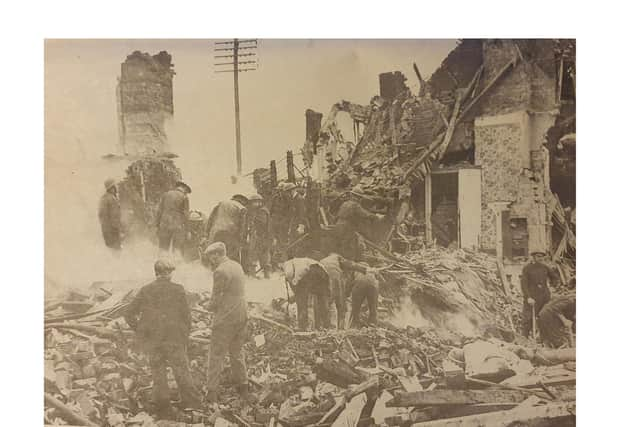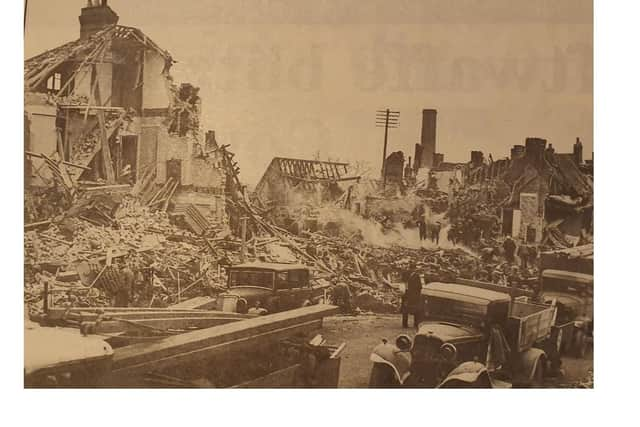'I was pinned down in glass and rubble but didn't suffer a single scratch, it was a miracle' - amazing first hand tales of when the landmines exploded in Kenilworth
and live on Freeview channel 276
Eighty years ago, Kenilworth experienced a dark chapter in its history when many civilians died during November 1940.
We published local historian Robin Leach's accounts of the events in last week's paper - and this week, we wanted to publish two first hand accounts of the night. The first is an account is from Jim Graham, who was 13 at the time and contacted us after reading the article in last week's paper. The second piece is an interview Robin did with Stan Kelsey, who was also 13 at the time. Stan came forward after reading Robin's research on the terrible events and provided a wealth of detail of wartime Kenilworth.
Advertisement
Hide AdAdvertisement
Hide Ad'I was covered in broken glass and rubble...I did not suffer a single scratch, it was a miracle.'


Comments from Jim Graham, who now lives in Offchurch
I was so interested to read the article about the landmine falling on Kenilworth on the night of November 20, 1940, because I was there! Not many people now can say that.
I was 13 at the time and living with my parents in Station Road. When the land mine struck I was in bed (downstairs) The back of our house was extensively damaged and the whole of the widow frame blew in on top of me pinning me in my bed. I was covered in broken glass and rubble. My mother rushed in and pulled the frame off me so I could get up. I did not suffer a single scratch, it was a miracle.
My father was in charge of the First Aid emergency response for the district and was one of the first on the scene. He was appalled at the casualties but afterwards said very little of the experience.


Advertisement
Hide AdAdvertisement
Hide AdThe crucial thing that never gets mentioned is that the siren did NOT sound, giving us the warning of a raid. If it had, mum and I would have been sheltering in our cellar as we did whenever there was a raid which that autumn and winter was a regular occurrence. On that night the all clear sounded about two hours later. Most nights the siren would sound about 8/9 p.m. and the all clear would not sound until around 2/3 a.m. when we could go to bed and get some sleep. Many times I had to do my prep down in the cellar, muffled up in warm clothes.
As the article says, the other landmine struck near the cemetery in Roseland Road and did no real damage. I remember the other incidents mentioned in the article, I wonder if the stick of bombs near Manor Road was the same stick that straggled the railway behind St John's Church and across to Cherry Orchard brickyard. there is no mention of the solitary bomb which destroyed the farmhouse in Rouncil Lane near the ford. There was a wild rumour that a spy had been signalling from there with a lamp!! I also recall seeing a bomber which I think was a Heinkel flying low over us on a daring daylight raid to drop it's bombs on Coventry Gauge & Tool in the Fletchamstead Highway.
Much has been written about the war but nothing can really capture the experience of having actually lived through those times which today seem almost unreal.
---------------------------------------
'I happened to see the bits and pieces going up in the flash'
Robin Leach's interview with Stan Kelsey
Advertisement
Hide AdAdvertisement
Hide AdStan Kelsey made me most welcome at his home to share his memories. Stan will be remembered by many in town as a coal merchant, though I suspect equally as many will not appreciate the vital role coal merchants once played in Kenilworth’s affairs. At the time of the Coventry Blitz, Stan was 13 years of age, living at Spring Lane where his parents had a shop.
With German aircraft roaring over Kenilworth through sustained anti-aircraft fire on their way to Coventry, following a radio beam transmitted from Cherbourg, Stan takes up the story:
“At the top of our yard between Henry Street and Albion Street, was a huge tree. My dad and I climbed a ladder to get to the branches; we could see over the rooftops and see the bright flare of Coventry. I remember my Dad saying ‘I think they’ve got Coventry station’.
"All of a sudden we could hear the whistle, there was a stick of bombs; one fell just outside the Working Men’s club billiard room, didn’t do a lot of damage, I happened to see the bits and pieces going up in the flash. Then one at Hyde Road, on the edge of the green by about number 14. Mrs Lawrence died.
Advertisement
Hide AdAdvertisement
Hide Ad"The next went through a shed, at the back of the fish shop in School Lane, where there were stables and other buildings; old Harry Wragg ran Jeffcoats the coal merchants and used to stable the horses and carts in there, the thing come through the roof, blew the floor and the doors off, and damaged the carts.
"One went off in Manor Road, Joe Richards had a butchers shop and he had a garden next to it; the garden now is the car park for the flats, it blew a hole in there. Right on the corner of Manor Road by the post box, on the grass verge there was a delayed action one and the bomb squad came and took that, on an army lorry on a cradle; it was only a small thing like a gas cylinder. The rest of the things they reckon went over Tainters Hill way. It was more or less in a straight line.
"Dad dashed down the yard and shoved me under the stairs with me mother…..got his car out and started to take the injured to St Johns (where the wartime First Aid station was).”
This quite extraordinary, detailed account raises an interesting question; with Coventry so well alight and easy to find, why did the aircraft drop its load early on Kenilworth?
Advertisement
Hide AdAdvertisement
Hide AdStan provides a likely answer: “The locals at the time said they let them go because the plane had been hit by ak-ak.
"They all reckoned they’d just let it go because it had been hit.”
If it is assumed the aircraft was flying on the alignment the stick of bombs landed, it appears the plane was veering off course and this would seem to back up Stan’s recollection. If this is the case then it may well be the only, and previously unknown, case of anti-aircraft fire from the Kenilworth area actually causing some damage. (Only one plane was actually shot down in the raid, but it would not have been this one).
Click here to read the previous story - Robin Leach's account of a dark chapter in the town's history when many civilians died during November 1940